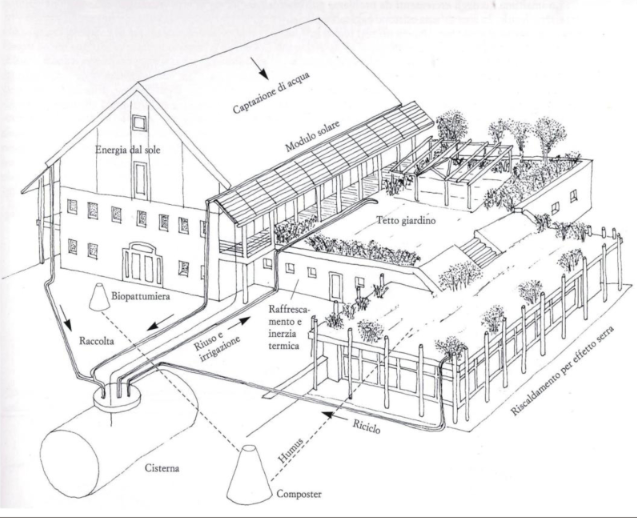From TKWB - Traditional Knowledge World Bank
Jump to navigation
Jump to search
| INNOVATIVE TECHNOLOGIES AND SOLUTIONS |
 |
| Technique: |
ARCHITECTURE FOR MANAGING ENERGY AND RESOURCES |
| Title: |
Ecological Habitation |
|
Description of the innovative solution
Ecological Habitation
The bioclimatic analysis of the situation of a place allows you to reap the best benefits from natural conditions. It directs interventions on passive architecture techniques, including natural ventilation, evaporative cooling, and drying agents, or by shielding, chimneys, and underground conduits. Additionally the heating is obtained in a passive solar method thanks to the masses of elevated thermal sediment or to the greenhouse effect with photovoltaic cells. With these principles it is possible to build an ecological habitation adapted to the local conditions. The photovoltaic cells can be inserted as tiles on the roof, make a cover for a porch, or be integrated into the glass of the windows. They are capable of producing the energy necessary for a home, as well as a surplus that becomes retained in the grid. The home can be equipped with the catchment of water on the roof for sanitary uses and to irrigate hanging gardens. Underneath the garden roof a habitable space is created naturally cooled by the above vegetation. The collection of waste and the compost produced in this way provide the fertile soil for the hanging gardens. Shielding and windows according to the exposure of the walls contribute to the heating during the cooler seasons and to the summer cooling. In the ecological home based on solar energy, the collection of water and the hanging gardens, the roof garden, formed by a covering of hanging vegetation, guarantees the best thermal isolation both in summer and winter. The homeostatic qualities of the plants in fact automatically adapt protection to the climatic conditions. It is possible in this way to reduce the energy consumed for heating by 50% and completely avoid electric air conditioning. During the summer, on a vegetated roof, the temperature does not exceed 25 degrees Celsius in comparison to 80 degrees on a conventional roof. The vegetation also improves air quality, producing oxygen and retaining dust. The urban advantages are so powerful that in Tokyo, where the average temperature has risen 3 degrees in the recent years, the city council has made it mandatory to substitute the tiles and cement with roof gardens.
Advantages and sustainability
The hanging gardens reduce the consumption of energy for heating and cooling, as well as improve air quality by producing oxygen and retaining dust. The collection of water and composting allow for a water and soil supply for these hanging gardens. The water collection also can be used in the home for sanitary purposes and solar panels capture renewable energy.
Images

Catchment of water, solar panel, roof garden, Heating from greenhouse effect, recycle, humus, composter, cistern,
reuse and irrigation, cooling and thermic inertia, Biopattumiera, collection, energy from the sun
Deepening
|
TRADITIONAL TECHNIQUE DATA
| Product manufactures: |
|
| Author: |
|
| Other authors: |
|
| Reference: |
|
|
|